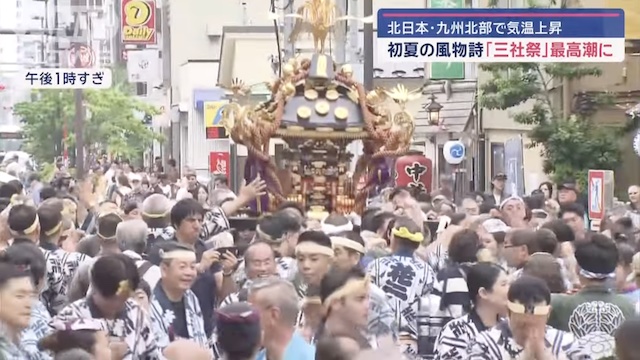TOKYO, May 19 (News On Japan) - Temperatures soared above 30C in northern Japan and northern Kyushu on Sunday, marking a true summer day, while weather conditions in western and eastern Japan worsened. In Tokyo, the early summer spectacle, the Asakusa Sanja Festival, reached its climax.

Tokyo's highest temperature dropped about 5°C from May 18, but the humidity made it feel hotter.
As the festival reached its pea, three portable shrines swayed within the grounds of Asakusa Shrine. This moment, known as 'Miyadashi,' is the highlight of Tokyo's Sanja Festival. The three shrines then set off, parading through the streets of Asakusa.
The shrine bearers stayed hydrated as they energized the downtown area.
Following this, the shrines returned to the temple grounds, marking the festival's climax.
Runner: 'The Heat Drained My Energy'
Temperatures rose in Kyushu and northern Japan, reaching summer levels in cities like Kurume in Fukuoka Prefecture.
The Fukushima City half-marathon began at around 8:30 AM Sunday morning, anticipating the afternoon heat, when temperatures were around 20°C.
Despite this, runners from various regions commented on the conditions.
A female runner from Aichi, who placed first, said: 'The heat definitely drained my energy. Standing still and exercising feel very different.'
A male runner from Chiba said: 'There were frequent hydration stations every 2-3 kilometers, and I repeatedly drank and poured water on myself. The abundance of hydration stations was a great help.'
This year's unusual heat led to an increase in hydration stations compared to last year, with water supplies increased by 2.5 times as a measure against heatstroke.
Meanwhile, children in Yamanashi were full of energy despite the heat. Wearing helmets and armed with sponge spears and swords, they re-enacted the Battle of Kawanakajima, with the Takeda army in red helmets and the Uesugi army in blue helmets. Victory was declared when all the opponent's flags were knocked off.
The Uesugi army in blue won the first round.
The heat also did not deter the spirited games in Kyoto, where a rugby match was held in a rice field. Players splashed water, passed the ball, and got covered in mud as they played. During the match, no one held back, even against female opponents.
This event started nine years ago to lift the spirits of Fukuchiyama City, which had suffered two consecutive years of flood damage.
The weather is expected to worsen, with rain forecast mainly in the Kanto region on May 20.
Source: ANN














